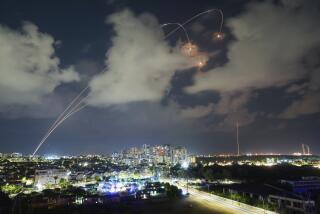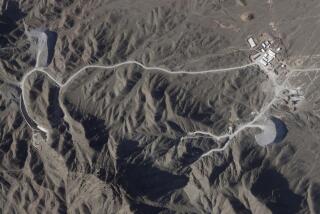Scientists Question Size of Israeli Nuclear Cache
- Share via
Israel may possess only half as many nuclear weapons as previously believed, according to a prominent group of American scientists who on Friday made public a high-resolution satellite image of Israel’s top-secret nuclear reactor facility.
Long a subject of speculation and controversy, Israel’s nuclear military capabilities are among the most closely held secrets in the Middle East. Israel has never publicly confirmed or denied having nuclear weapons, although the fact of their existence is not in doubt.
Widely published estimates have suggested that the country has as many as 400 nuclear weapons in its arsenal. But the new image of the Dimona Negev Nuclear Research Center shows that the reactor there probably could not have produced enough plutonium during the last several decades for many more than 200 bombs, according to analysts with the Federation of American Scientists, which studies national security issues.
Independent U.S. national security analysts, however, cautioned that even the best pictures of the nuclear weapons complex could be misleading. The Israeli government operates the reactor facility with a self-conscious security eye to what can be observed from orbit, they said.
“The Israelis have put enormous amounts of attention and care to methods of concealment,” said Avner Cohen, a senior research scholar at the National Security Archive and the University of Maryland who is author of the book “Israel and the Bomb.”
“They are very much aware of the abilities of satellites,” Cohen said. “Even though now we have for the first time a very nice visual sense of the site, this is not sufficient to draw firm conclusions about what is going on inside.”
The pictures of the classified nuclear complex are the newest in an online archive of satellite images showing secret nuclear weapons complexes and missile facilities around the world. They were taken July 4 by a private surveillance satellite called Ikonos, operated by Space Imaging Corp. in Colorado, and posted Friday by the federation’s Public Eye Project on the Internet at https://www.fas.org.
The black-and-white image reveals in new detail an elaborate complex encompassing a heavy-water reactor, a fuel reprocessing installation, two cooling towers, office buildings and waste disposal sites sprawling across tens of square miles of the Negev Desert between Beersheba and the Dead Sea, about 25 miles from the Jordanian border.
About 2,700 scientists, technicians, administrative staff and other workers are employed there. The facility is concealed from sightseers by groves of palms and landscaped gardens. It also is set off by three cordons of security fencing and defended by what may be antiaircraft missile sites.
To draw their conclusions, the federation analysts gauged the Dimona reactor’s capacity for producing weapons-grade plutonium by counting the cooling towers clearly visible in the picture taken from orbit. They also compared the new imagery with recently declassified pictures taken by U.S. spy satellites in the 1960s and early 1970s.
Taken together, these satellite images suggest that the Dimona reactor could have produced about 20 kilograms of weapons-grade plutonium every year, about half what some experts have speculated. That is enough plutonium for no more than “between 100 and 200 bombs over the last third of a century,” said federation analyst John Pike.
In the United States, Israel enjoys a special legal protection from prying public eyes in space that is not provided to other countries.
“Even though American remote sensing satellites can take pictures at 1-meter resolution, U.S law requires [the firms] to sell it at 2-meter resolution” if the pictures show sites in Israel, said Mark Brender, the satellite firm’s director of Washington operations. “It is still pretty good.”
More to Read
Sign up for Essential California
The most important California stories and recommendations in your inbox every morning.
You may occasionally receive promotional content from the Los Angeles Times.













